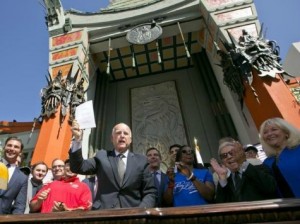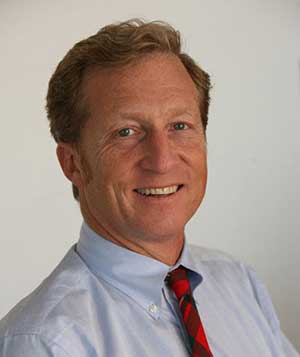This is Part ll of Brown Administration Tied To Scandal That Took Down Oregon Governor.
Recent revelations resulted in the Feb. 13, 2015 resignation of Democratic Oregon Gov. John Kitzhaber over collusion between the California and Washington State governors’ offices, Kitzhaber’s office, and environmental groups, to force climate policy coordination and collaboration across the U.S., I reported in my story last week.”
Emails from 2013 and 2014 reveal Kitzhaber agreed to a deal with the governors of California and Washington, to implement low-carbon fuel standards and develop a scheme to foist green-energy agendas on multiple states. And throughout the emails, Hedge Fund Billionaire Tom Steyer is mentioned.
It is no coincidence Gov. Jerry Brown, D-California, has made climate change one of his top priorities, with a billionaire like Steyer funding the possibilities. In January, Brown announced plans to require 50 percent of all energy use come from renewable sources such as wind and solar, as well as a 50 percent reduction in automobile gas consumption.
At the September People’s Climate March in New York to kick off the United Nations Climate Summit, Brown told the world that California is the model state to emulate when it comes to fighting climate change, Breitbart reported. “Carbon pollution kills,” Brown said, ignoring scientists who say otherwise. “It undermines our environment and in the long term it is an economic loser.”
Who is Tom Steyer?
Billionaire climate change activist Tom Steyer made his fortune investing in the energy sector, through his hedge fund company, the Farallon Capital Management fund, which Steyer managed until 2012. Farrallon invested in coal mines in Australia and Indonesia, as well as in tar-sands oil, which is strip mined, processed to extract the oil-rich bitumen, which is then refined into oil. It’s an interesting career change and about-face.
“And then there’s the Brown family’s semi-secret financial ties to the military dictatorship of Indonesia, a book-length saga unto itself,” columnist Dan Walters slipped into a column in 2010.
Steyer founded NextGen Climate, an organization immersed in green cronyism. NextGen is a 501(c)(4) organization, and the NextGen Climate Action Committee is a political action committee fighting the Keystone Pipeline. Steyer said on the NextGen blog that while climate change had not always been on his radar, he came to believe he could no longer invest in fossil fuels – after becoming a billionaire.
Many call Steyer a “ridiculous hypocrite” who built his multi-billion dollar-fortune by buying up foreign coal. But now Steyer uses his coal and energy fortune to try and manipulate the California and national political processes. Described as a “billionaire oligarch” by the New York Times, Steyer and NextGen Climate Action Committee spent approximately $73 million in the 2014 mid-term elections, but didn’t fare so well. “He’s setting his sights on 2016, saying his NextGen Climate political action committee was never conceived as a ‘drive-by super PAC,’” according to SF Gate.
Steyer has also met with President Barack Obama to discuss what the White House will do to address global warming.
The New York Times reported that the Farallon Capital Management fund’s investments in Australian and Indonesian coal mine increased their annual production by about 70 million tons – “more than the amount of coal consumed annually by Britain.”
On the blog of NextGen Climate, which Steyer founded and is President, he wrote that while climate change had not always been on his radar, he came to believe he could no longer invest in fossil fuels.
Steyer is also a backer of the San Francisco–based Energy Foundation, which gave Gov. Kitzenhaber’s fiancée, Cylvia Hayes $40,000 in 2013 to create a green-energy communications strategy. Steyer’s TomKat Charitable Trust has donated more than $3 million to the Energy Foundation, according to the Washington Free Beacon, and Inside Philanthropy.
Steyer also helped Hayes fund her $118,000 Clean Economy Development Center fellowship. However, Hayes failed to disclose those payments, despite her close relationship and position with the governor as an “informal adviser.”
“While Hayes was living in the governor’s mansion with the self-bestowed title of ‘Oregon’s First Lady,’ she collected a series of consulting contracts and ‘fellowship’ money from people with an interest in shaping state energy and environmental policy,” explained John Fund with National Review. “She then ordered state employees to help run her private business and take actions in accord with the wishes of the green-energy groups that were paying her.”
Acting as Oregon’s first lady, Cylvia Hayes attended private conferences and public events, and shared her passion and work for clean energy, low-carbon fuel and the need for West Coast leadership on climate change — all priorities for Gov. Jerry Brown as he embarked on an historic fourth term in office.
“In the wake of Kitzhaber’s resignation last week and in the face of allegations that the first couple crossed ethical and perhaps even legal boundaries by conflating Hayes’ private and public work, many of those same policies have fallen under suspicion,” E&E Publishing recently said.
“Investigations into the couple’s conduct by federal and state prosecutors have been launched, with a separate investigation by the Oregon Ethics Commission pending their results (Greenwire, Feb. 1 6). Along with emails, receipts and tax records, federal prosecutors have requested any communication relating to ocean acidification and renewable fuel standards, policy measures for Kitzhaber on which Hayes played a promotional, and sometimes advisory, role.”
‘Epic Hypocrisy’
Steyer has been and continues to be a vocal Keystone Pipeline opponent, however he frames divestment as a moral issue. This apparently depends on the definition of the word “moral;” Steyer stands to add to his billions if the Keystone Pipeline project is killed. Perhaps he does have the President’s ear.
“Steyer is the ultimate rent-seeker who depends on government connections to produce subsidies and mandates that make his “green” energy investments profitable,” John Hinderaker of Powerline Blog explained last fall. “He also is, or was until recently, a major investor in Kinder Morgan, which is building a competitor to the Keystone pipeline.”
Steyer pushed for divestment at Stanford, where he is a trustee, even though he made his fortune investing in the energy sector.
Read the Powerline story to understand the depth of Steyer’s investments in coal;
“Mr. Steyer has had a direct, personal involvement in assembling, through Farallon, a portfolio of strategic investments in overseas coal miners and coal fired power plants which is unprecedented in scale. The total quantum of Farallon’s investments in these transactions is not publicly disclosed, but reasonable estimates suggest that it could be between US$1 and $2 billion in total.6 Taken collectively, the coal producers in which his fund has amassed these investment interests represent one of the largest sources of thermal coal in the world.”
All of this climate change scheming started with the United Nations, prior to Al Gore claiming it as his own brilliant plan. It was established in 1992 at the United Nations Conference on Environment and Development in Rio de Janerio, Brazil.
Tie it all together
June 30, 2008, the leaders of Alaska, British Columbia, California, Oregon, and Washington signed the Pacific Coast Collaborative Agreement, amounting to a ‘compact,’ which is prohibited between states without Congressional approval.
And this isn’t the first such compact; the California Air Resources Board, a state agency, entered into a compact with Québec to carbon trade. The Air Resources Board original plan was to create a giant climate change coalition with other states and provinces from which carbon trading and taxing would emanate. But one by one, states dropped out, citing the difficult economy and cost to manage such a program. California instead “linked” with Québec for cap and trade carbon auctions.
California already is known as the lead state in over-reaching environmental laws, but Gov. Jerry Brown says existing efforts are not enough.





